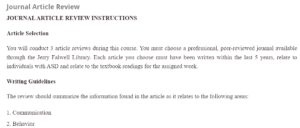Journal Article Review
Introduction
Gunning et al.’s (2018) article points out that there is increasing enrollment of children with ASD in the preschool setting. However, there is an increasing concern as regards the communication and social deficits that are commonly observed in ASD children. Such deficits in skills may have a negative effect on peer relationship development and act as a learning barrier and a hindrance to the successful inclusion in society for ASD preschool children. Thus, the authors chose to investigate the literature on Peer-mediated interventions (PMI) in skills implementation for teaching children with ASD. The literature investigated was within the early learning environmental context. The authors noted that PMI advantages far outweigh adult interventions. However, no research evaluates PMI use with populations from younger demographics. The authors thus aimed to conduct a literature synthesis regarding the PMI use in teaching skills for ASD children within preschool settings. The authors searched literature on the subject published between 1980 and 2018, yielding 31 articles for inclusion. The results of the research proceeded to discuss the relation of peer characteristics with participants, the target skills, PMI procedures, research strength, and the intervention outcomes. The PMI effectiveness was also discussed, as well as the areas that need future research. Hire our assignment writing services in case your assignment is devastating you.
Communication
Gunning et al. (2018) assert that the impairment in skills that ASD children experience often acts as a hindrance in their ability for incidental learning through exposure to their peers, as particular support is lacking. It has been noted that the presence of barriers warrants the need for strategies and interventions that are evidence-based and necessary for supporting children with ASD (Boutot, 2017). This will allow these children to access the benefits that come with being in an inclusive setting through successful interactions with their peers. In other words, when children with ASD are put in learning settings together with their peers, there is a higher likelihood of improved communication between the two and, hence, an improvement in coping and learning skills.
Behavior
The authors, in their review, showed that age peers in preschool demonstrated abilities that were exceptional as regards new skills acquisition and that support learning for children with ASD. The authors also noted that when the peers had learned how to use the Speech Generating Device successfully, they were able to successfully teach ASD children to use the gadgets despite the former group not having any prior experience in using the same device (Gunning, Breathnach, Holloway, McTiernan & Malone, 2018).
Social Skills
In terms of using the PMI in teaching skills for preschool children with ASD, Gunning et al. (2018) showed that there are several benefits. Also, Boutot (2017) points out that PMI can be used to teach a wide range of skills in the domains of social and communication competence. However, the authors stated that there is a need for additional research to be done on utilizing PMI in teaching other repertoires of skills (such as imitation and pre-academic skills). This is mainly because the authors found limited research that targeted the said skills. Further, the authors noted that the analysis they used in the literature review was used to identify the results as negative, mixed, or positive and failed to indicate the magnitude of the gains of the interventions. The authors added that future research needs to employ more analyses as well as techniques that are meta-analytic in the development of social skills. PMI offers a treatment approach that is robust in targeting social deficits for ASD children.
Conclusion
The literature review by the authors showed that the implementation of PMI, where peers are included, appears to be effective. Effectiveness, in this case, includes improved communication between children with ASD and their peers. Acquisition of skills through emulating their peers’ behaviors.
References
Boutot, E. A. (2017). Autism spectrum disorders: Foundations, characteristics, and effective
strategies- With access (2nd ed.). Upper Saddle River, NJ: Pearson.
Gunning, C., Breathnach, Ó., Holloway, J., McTiernan, A., & Malone, B. (2018). A systematic review of peer-mediated interventions for preschool children with autism spectrum disorder in inclusive settings. Review Journal of Autism and Developmental Disorders, 6(1).
ORDER A PLAGIARISM-FREE PAPER HERE
We’ll write everything from scratch
Question
Journal Article Review
JOURNAL ARTICLE REVIEW INSTRUCTIONS
Article Selection
You will conduct 3 article reviews during this course. You must choose a professional, peer-reviewed journal available through the Jerry Falwell Library. Each article you choose must have been written within the last 5 years, relate to individuals with ASD and relate to the textbook readings for the assigned week.
Writing Guidelines
The review should summarize the information found in the article as it relates to the following areas:
- Communication
- Behavior
- Social Skills
Summarized information in each area may directly relate to the article or may be implied based upon supporting information from the course text.
Each review must be 2 pages (excluding title and reference pages) and follow current APA format (including in-

Journal Article Review
text citations and headings). Each article should include at least 2 sources (course text and selected article); however, additional references are encouraged. In-text citations should be included for each of the 3 specified areas and references provide at the end of the review. The review should include an Introductory and Closing paragraph as well as a paragraph for each of the 3 required headings (communication, behavior, social skills).
- The introductory paragraph should provide a brief overall summary for the article and/or study conducted.
- The paragraphs for each of the 3 headings should address information specific from the article regarding the respective heading. Clear links should be made between the article and assigned weekly readings.
- The closing paragraph should include a clear summary of the main points of the article and implications for supporting individuals with ASD.
Textbook
- Boutot, E. A. (2017). Autism spectrum disorders: Foundations, characteristics, and effective strategies- With access (2nd ed.). Upper Saddle River, NJ: Pearson.

